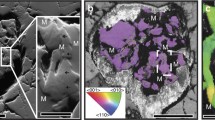Abstract
The breakdown of hydrous minerals involves multiple reactions of dehydration and often oxidation of ferric iron. Such reactions are important in mantle metasomatism, metamorphic petrology and material sciences. Here we track these reactions dynamically over the temperature range from 400° to 1100° C using Y-doped ZrO2 sensors in a novel manner, comparable to differential thermal analyses. This contrasts to the conventional use of ZrO2 cells in equilibrium electrochemical measurements for oxygen fugacity.
Similar content being viewed by others
References
Arculus RJ, Delano JW (1981) Intrinsic oxygen fugacity measurements; techniques and upper mantle peridotites and megacryst assemblages. Geochim Cosmochim Acta 45:899–913
Brindley GW, Lemaitre J (1987) Thermal oxidation and reduction reactions of clay minerals. In: Newman ACD ed., Chemistry of clays and clay minerals. Mineral Soc Monogr 6:310–370
Burkhard DIM, Ulmer GC (1995) Kinetics and equilibria of redox systems at temperatures as low as 300° C. Geochim Cosmochim Acta 59:1699–1714
Burkhard DJM, Hanson B, Ulmer GC (1991) ZrO2 oxygen sensors: an evaluation of behavior at temperatures as low as 300° C. Solid-State Ionics 48:333–339
Claussen N, Rühle M, Heuer A (1984) Advances in ceramic sciences and technology of zirconia II. Proceedings of a conference in Stuttgart 1983. Am Ceram Soc p 842
Elliott WC, Grandstaff DE, Ulmer GC, Buntin TJ, Gold DP (1982) An intrinsic oxygen fugacity study of platinum-carbon associations in layered intrusions. Econ Geol 77:209–226
Eugster HP, Wones DR (1962) Stability relations of the ferruginous biotite, annite. J Petrol 3:82–125
Farmer VC, Russell JD, McHardy WJ (1971) Evidence for loss of protons and octahedral iron from oxidized biotites and vermiculites. Mineral Mag 38:121–137
Ferrow E (1987) Mössbauer and X-ray studies on the oxidation of annite and ferriannite. Phys Chem Minerals 14:270–275
Hogg CS, Meads RE (1975) A Mössbauer study of thermal decomposition of biotites. Mineral Mag 40:79–88
Huebner JS, Sato M (1970) The oxygen fugacity-temperature relationships of manganese and nickel oxide buffers. Am Mineral 55:934–952
Knauth LP, Epstein S (1982) The nature of water in hydrous silica. Am Mineral 67:510–520
Muse S, Soejima S (1983) A method of producing oxide sensing ceramics. European Patent #0-345-824-Al granted to NGK Insulators, LTD and extended to Germany, France and England.
Rimsaite J (1970) Structural formulae of oxidized and hydroxyldeficient micas and decomposition of the hydroxyl group. Contrib Mineral Petrol 25:225–240
Rinne F (1924) Bemerkungen über strukturchemische Silikatformeln und den kristallographisch-chemischen Ab- und Umbau von Glimmer duruch Entwässerung, Oxidation und Reduktion. Akad Wiss Leipz Verh 76:1–11
Sanz J, Gonzalez-Carreño T, Gancedo R (1983) On dehydroxylation mechanisms of biotite in vacuo and in oxygen. Phys Chem Minerals 9:14–18
Sato M (1965) Electrochemical geometry; a possible new method of geothermometry with electroconductive minerals. Econ Geol 60:812–818
Sato M (1971) Electrochemical measurements and control of oxygen fugacity and other gaseous fugacities with solid electrolyte sensors. In: Ulmer GC Ed., Research techniques for high pressure and high temperature, pp 43–99, Springer, New York-Amsterdam-Berlin
Sato M (1972) Intrinsic oxygen fugacities of iron-bearing oxide and silicate minerals under low total pressure. Geol Soc Am Mem 135:279–306
Tripathi RP, Chandra U, Chandra R, Lokanathan S (1978) A Mössbauer study of the effect of heating biotite, phlogopite and vermiculite. J Inorg Nucl Chem 40:1293–1298
Ulmer GC, Rosenhauer M, Woermann E, Ginder J, Drory-Wolff A, Wasilewski P (1976) Applicability of electrochemical oxygen fugacity measurements to geothermometry. Am Mineral 61:661–670
Vedder W, Wilkins RWT (1969) Dehydroxylation and rehydroxylation, oxidation and reduction of micas. Am Mineral 54:482–509
Veith JA, Jackson ML (1974) Iron oxidation and reduction effects on structural hydroxyl and layer charge in aqueous suspensions of micaceous vermiculites. Clays Clay Minerals 22:345–353
Author information
Authors and Affiliations
Rights and permissions
About this article
Cite this article
Burkhard, D.J.M., Ulmer, G.C. Dynamic tracking of mica breakdown reactions with electrochemical measurements. Phys Chem Minerals 22, 507–510 (1995). https://doi.org/10.1007/BF00209376
Received:
Revised:
Accepted:
Issue Date:
DOI: https://doi.org/10.1007/BF00209376




